|
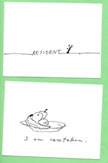
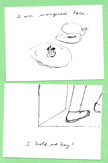


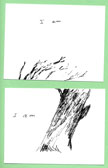

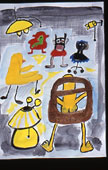



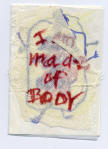 |
Excerpts from ARTISTS AND MENTAL ILLNESS: GOING TO THE HOSPITAL, GOING TO THE ARTISTS' COLONY
©Ann Starr
The James Campbell Distinguished Lecture Rush
Presbyterian St. Luke's Medical Center, Chicago
Delivered on 26 January 2000
What an unfortunate title for Dr. Kay Redfield
Jamison's book about artists and bipolar disorder:
Touched With Fire: Manic-Depressive Illness and the
Artistic Temperament. "Touched with fire?" Excuse
me? Shouldn't that be Burned Alive? I am a visual artist
with manic-depressive illness. I have never felt myself
"touched with fire," or visited by any gods. I am more
likely to feel incinerated. As with the trash.
Dr. Jamison impressively lists in Appendix B many artists
who suffered (nota bene the simple past tense; none
suffer in the present) bipolar illness. She notes with an
authoritative variety of daggers and bullets (not by
accident are they collectively called dingbats) who is known
to have been hospitalized, or to have attempted suicide, or
to have succeed in the effort—that is, in an effort no one
could ignore or mistake. Did Janis Joplin commit suicide by
pursuing drugs and a tormented life in the fast lane?
Jamison tends to prefer the straightforward, like Sylvia
Plath and her definitive, pilot-lit way out.
Jamison's fascinatingly wide-ranging—and undated—list of
artists to whom she attributes bipolar disorder includes
people from historical periods and cultures with a variety
of points of view on idiocy, religion, illness, inspiration,
and brain disease. She includes Michelangelo (fifteenth
century: 1475-1564). There is John Bunyan (1628-1688) in
there along with Robert Burns (1759-1796); everyone's
favorite madman, Vincent van Gogh lived from1853-1890, and
Anne Sexton form1928 to 1974. While we know next to nothing
about some and have well-documented biographies of others,
all are diagnosable in the interest of a theory today. It's
an interesting study in anachronistically applied terms and
concepts at least.
Whether or not those folks were bipolar, I am interested
that the tormented Joplin is missing, as are Jimi Hendrix
and Kurt Cobain. Not only are there no artists noted from
popular culture, but entirely absent are landscape
designers, architects and engineers, graphic artists,
weavers, set designers, aesthetic surgeons and
orthodontists, quilters, disc jockeys, actresses who wait
tables and await roles, photo journalists, cooks and bakers,
or city planners. And what about authors whose excellent
fictions have not appeared during decades of retrenchment in
publishing? I'll leave to someone else the mathematicians,
physicists and botanists, whose "creative temperaments
certainly inform their work.
Oh no: could they possibly be artists too?
Well, of course not. For the purposes of research, the
Artist is always someone both dead and immortalized within
the most conservatively-construed genres. Their work hangs
in the Prado, is heard at Alice Tully Hall, or is taught
from a Norton Anthology of a western literature. The
definition of artist is exclusive and romantic.
Real artists have widely-acknowledged reputations and
universally acknowledged death certificates. Like most
living artists, I will remain unacknowledged for the
research record.
When I meet a new psychiatrist, they ask questions born
of such authority-born skepticism, questions like these:
"So you are an Artist? What kind of art do you make?"
As if this will clear it up. What they want is not what I
do or how I think, but if I paint on velvet.
Next, "Where is my studio?" ("At home" would be sufficiently
damning, but I trump that because I don't even have a
studio. I work when I can earn space at artists' colonies,
the existence and purpose of which institutions doctors know
nothing of.)
Third question: Do I show my work? (In fact, I exhibited in
thirteen shows across the country last year and in fourteen
the year before. Why should a psychiatrist know the Center
for Book Arts or any of the other galleries and museums I
show in?)
On top of it all, I have no more training as an artist than
two audited drawing courses at a liberal arts college, and
one life-drawing class I paid for at an art school.
But the point of all these questions is, "Are you a real
artist?" with their expected conclusion that I am not
because no one has ever heard of me. Obviously, no one wants
to be taken in by the claims of a nut, and psychiatrists
screen for symptoms like grandiosity. But it's a
disingenuous question anyway since most doctors appear to
believe, like Jamison, that real artists are dead artists,
or are well accounted for in the press.
Artists, like psychiatric patients, are potential tricksters
because our roles are not easy to identify. Few are lucky
enough to pursue art full-time. I have been challenged in a
therapy group (not by the doctor, I admit) by the
proposition that I am merely a "frustrated housewife who
paints." That I am a frustrated housewife is absolutely
true. It in no way precludes the fact that I am an artist—a
real, live artist afflicted by manic-depressive
illness that can thwart her work from time to time.
Few recognize either that mental illness is rarely a
full-time, whole-consuming occupation. People who live
neither as an artist nor mentally ill person rarely have the
imagination to conceive of concentrated or heightened states
of mind as other than actively threatening to them. It too
rarely occurs to people that mental illness affects the
afflicted, who, like everyone else, would like to get on
with their lives and work as well.
—
Jamison cites many types of studies concluding that
artists are unusually prone to be bipolar, thus linking
bipolar illness and "the creative temperament." Perhaps,
then, bipolar illness is integral to the artistic process?
But Jamison also demonstrates that of all the major
psychiatric diseases, bipolar illness is more likely than
any other (schizophrenia included) to result in suicide.
What have we got in this extraordinary package of suicide
and creativity?
I know that for any person harboring suicidal thoughts, to
remain alive requires substantial strength and creativity.
This is a point worth making very, very clearly: Duration is
the most common presupposition in life. But it is an
assumption, and it can be belied. For the suicidal
person, creativity is not light bulbs illuminating overhead.
This creative force—the sorely challenged life force—goes
under the condescending popular terms of "willpower," or
"grit," stubbornness, or even orneriness. But the effort to
keep life together is the supreme creative effort, however
miserable or degraded the forms it takes may appear to
bystanders.
As a manic-depressive person, first I survive. Everything
else requires creativity of a much less demanding order.
I include among the lesser tasks such central ones as my
need to create—out of and apart from my own horrors—a
wholesome place for my family. Important, too, but less than
survival, is trying to imagine into existence a life for
myself, where the core rot is halted, maybe even
repaired a little. A little farther down the line, I do the
things artists are thought to do.
Against all this, manic-depressive illness is a big overlay.
It is the constant threat to my life. This is not an
inspiring illness; quite the opposite. It stresses a finely
tuned and perceptive person to literally intolerable
excesses of emotion. It is the rack. Mania can so urgently
require abatement that only three things can relieve it: the
dumbest depths of comatose depression, heavy and consistent
intake of medications (include drugs and alcohol here), or
suicide. There is no art making in these circumstances. I
make art between psychiatric episodes, and despite them.
My pain is partly generated by—and is focused by—the
pattern of life bipolar illness forces upon me. When my work
is about the illness, it is about it in this way: I can see
nothing without seeing it. It is like cataracts, or
hallucinations, imposed upon one's vision. During an
episode, I am reduced to a single-issue life. I have to keep
body and soul together. Then there is no work but
self-protection, which is one experience I believe art can
never express. Art may provide a means of reflection or
therapy for some, but a person deciding whether to live or
die has no other decision to make.
Let me offer another way to see the interconnections between
being an artist and being mentally ill, specifically,
bipolar. In different locations, one can see oneself in
different perspectives. My illness has taken me to an
institution for mentally ill people: I have been an
in-patient on a locked ward of the psychiatric hospital
several times in the past six years. Throughout the same
period, I have also been a resident for several periods of
two weeks or more at art colonies, where artists may go to
do their creative work without constraints or interruptions.
Although it sometimes feels like it, you don't have to apply
to get into the hospital; for colonies you do. Sometimes you
are accepted, sometimes not. When you leave the colony
though, it's on a schedule you've pre-determined; when you
leave the hospital, you are shown the door.
From CONCLUSIONS:
Some creative urge can be found in every person, no
matter how dull or thwarted the life. Unfortunately,
expression of individual creativity can be impeded forever,
like the acknowledgment and expression of emotion can be.
There are good reasons to compare exploring one's creativity
with undertaking a regimen of self-reflection or
psychotherapy. In both, there is much delight to gain
through release of imagination and gain of insight; but
there is a lot of room for uncontrolled, terrifying
discoveries too.
I think that many people sense their own creative
temperaments, but are no more willing to put them to work
than to pursue psychotherapy: Too risky! This point might
give us some perspective, then, on the amount of simple, raw
work done by people who suffer mental illness yet continue,
on top of it all, to be artists. It takes courage to keep
exploring life's open questions, daily, at the most personal
level as well as through art-making.
I never chose to be mentally ill, but I am. I can, however,
choose to mitigate the effects my illness has on the rest of
my life by undertaking a rigorous individual therapy, taking
my drugs as prescribed, going to the hospital if I am
suicidal, and by continuing to go to the colonies
where both my art, my health, and even my ability to lead
daily life are served.
Did I choose to be an artist? Yes and no. It's a calling,
not a job. If I call myself a "professional artist," it
doesn't mean only that I wish to make the money I don't from
my labors. It means that I will pay the price for my
decision: the challenges from others, the delayed rewards
and gratification, the likelihood I will not find a
substantial audience for my work.
People like Kay Redfield Jamison can get away with
romanticizing artists with mental illness because, as a
psychiatrist and sufferer herself, she understands that pain
is central to both the work of art making and the work of
being alive and fully human. In linking the artist to
mental illness, however, she becomes an apologist for
everyone who recognizes a creative urge but fears the
consequences of acting upon it.
There are real rewards for pushing one's creativity hard,
but there are also many uncertainties and bitter
disappointments. Link the artist with something like bipolar
disorder and you get not only "obvious" reasons for failing
to use one's own creativity, but a subtle way to transfer
fear and hostility to those who do—to those whose efforts
may challenge you or make you uncomfortable for your
inability to stretch farther.
One durable characterization of artists in our culture is
that they are bizarre, irresponsible, immoral, or
anti-social people. Mental illness is a handy catchall for
any number of unusual or uninterpretable traits. For the
socially insecure, being artistic isn't a compliment: "I'm
not mentally ill; no muse is visiting me. I may not be an
artist, but at least I am unquestionably sane." The artist
becomes the cultural "carrier" of a dreaded condition with
agreeably ill-specified symptoms that are diagnosable by any
person who nominates him- or herself as 'normal.' Any artist
can be the suspicious object of fear, admired—if at all—only
in quarantine.
THE BODY INSIDE ME
© ANN STARR
Northwestern University Medical School, 1999
Addressed to an audience of medical students and
physicians and subsequently
revised for the Barnard Feminist Art and Art History
Conference, October, 2000
Let's start by remembering that the artist, scientist,
and doctor once existed in the same person. Once, the
connection that I assume between observing, drawing, and
knowing was taken for granted. Once, too, anatomy was
completely new to the eye and the hand. The Renaissance and
its explorers opened many continents only posited by ancient
imaginations. Then, somewhere along the line, the doctors
and the artists got separated.
Gross anatomy is no longer a field of primary discovery.
While you medical students may explore an individual
cadaver, many of your "discoveries" are precedent
certainties planted by lecturers and lab instructors,
confirmed by atlases and Grant's Dissector. Early on in my
medico-artistic explorations, an anatomist friend deflated
my novice enthusiasm by telling me that a new muscle had
been discovered in the jaw a few years ago. So much for
romance.
Like most artists, my first body explorations came in a
life drawing class. Many artists proceed to take not only
life drawing but also anatomy for artists. They are
introduced to the skeleton and superficial muscles as a way
of improving their renderings of the exterior.
You get (dead) cadavers; we get flexible,
posing models. Both sorts of specimens create high emotion
in the learners, emotion that must pique students and which
necessitates firm boundaries in our responses. Another
similarity is that cadavers and models share a certain
self-selection principle. But while I gather that people of
many looks and histories commit their bodies to medical
education, the models who commit themselves to artists are
generally—not always, thank heavens—the young, lithe, and
beautiful. The art of the figure is thought to glorify human
beauty. Rarely drawn in art schools are dwarfs, elderly
persons, cripples, or obese people. An essentially Vitruvian
aesthetic still dominates, idealizing proportion.
Models' bodies are artists' basic training, as cadavers
are for you. The more one draws the body, the better one
knows it and can use it to convey one's own subjects and
meaning. Models have ceased to be necessary for me. My
real work is not rendering, any more than yours will be
identification of tendons.
My own drawing has never been without high emotional
content. For me, the body is emotion, feeling,
passion, disguise and revelation. I've come to draw and
paint the body almost exclusively for all of the intense
content that you are being trained to handle with the utmost
control. As my drawings elongate the curve of a back, or
express themselves in a tumult of twists, I call forth the
attractions and fears you will have to suppress in order to
work at all. They're all there, though: All the time.
You are learning not to respond overtly to the sexuality,
beauty, exposure, grief, or grotesquerie of the body. Like
every human, you will know it profoundly nevertheless. No
less than I, whose business is expression, you will never be
free from it.
Now, interestingly enough, when it comes to the
interior of the body, the whole picture changes. This is
considered your exclusive domain: Initiation is emphatically
required. Where the naked body is culturally the locus of
infinite passion and fantasy for everyone, the interior
elicits very few, and almost entirely fearful responses. We
non-doctors shun it. To look inside the body is to face
death; it is absolutely taboo for everyone—except for you.
You are entering what our culture has made almost literally
a priesthood. Your ability to do and survive this remarkable
looking is your source of power. You neither die nor grow
ill nor poison the rest of us as a result. We in the laity
are happy to have you do it. We would not.
At least, most of us wouldn't. But I would. I hope I can
explain this naturally occurring oddity.
My career drawing the figure reached an impasse a few
years ago. These two slides show some of my last full-figure
drawing. For these I hired models. They moved continually as
I drew, recording their cores and limbs in motion, as a way
of pressing, pressing to express the excitement and emotion
of the body, virtually dissolving the flesh in the visual
record of the action. Such difficult work it was, and such
emotional intensity in the act of drawing.
Now, I will allow that the emotional intensity is
conveyed by these records; but it is certainly legitimate
for you or any audience fail to see that the body is in
these drawings. But I didn't like it that the passion was
spinning out of the flesh. Feeling is integral to bodies and
I am not interested in abstracted, but in located emotion.
So, is it possible to isolate this location without words?
If so, where can I find it?
If human—as both emotion and sensation—inheres in the body,
how can I convey its depth, force, and complexion without
resorting to time-worn visual tropes? No artist works
unburdened by what others have done. The nude is highly
eroticized throughout history, and there's no dismissing
that. Bones, including the skull, have been reduced for
centuries to simple emblems of death—it would be almost
impossible to get them to carry any other significance. And
exposed sub-cutaneous flesh implies violence. So, all in all
this makes for a very limited emotional palette despite the
body's obvious richness. Isn't there something between the
limitations of representational conventions and the
multifarious, problematic experience of actual flesh?
Well, there are symbols—as in this small drawing, "The
Group." In this piece it is impossible to distinguish the
"figures" from the "chairs." The furnishings offer another
way to reveal the emotion in the figures. It also allows a
way to work past the associations viewers are ready to make
with people's state of dress or undress, so the content I'm
interested in isn't obfuscated by associations with either.
This image of a cross, is another way to draw the figure
symbolically; and this next image, with its surreal grouping
of figures uses fanciful distortions of human form as a way
to convey a crowd of emotions.
But in this drawing, "Eureka Portable," I really began to
get the idea. (Eureka portable being, for those of you still
innocent, a small canister-style vacuum sweeper.) The figure
is represented symbolically, but its own parts
constitute the symbol. The uterus, vagina, full lips and
little-girl dental gap add up to the object-person. The
emotion is not conveyed by a vision of an objectified
exterior, but by the subject's own guts—her emotion
is inside and reveals her feelings about her objectified
presence in the outside world.
Eureka, indeed! It has been ever since as if the organs,
the interior cavities and body's byways were my very own
discovery—as, of course, they are! To find that there is so
much of a body still to explore and work with, so much that
is not pre-charged with convention. Deep inside there is a
world that does not come first to the eye—to think of it
plunges us into real terra incognita, to be explored
through imagination and the levels of fantasy we must work
hard to eke to the surface.
Now, I say that none of what we experience inside is ever
known visually. That's not true, because medicine sees this
every day. That's a huge exception. I have already alluded
to the taboos about the interior and the need we all have to
avoid looking at it directly. As I mentioned, a sine qua
non of medicine is to objectify and distance in order to
make bodies treatable and tolerable for doctor-humans as
well as for the rest of us.
Because of medicine in general education, all of us know
what the various organs "look like." I think, though, that
anatomical imagery does more than record and inform: it
protects us all, too. Radiology, medical illustration—even
the fact that we are still satisfied with the world view
implied in the elegant Vesalius—suggest that we are
contented with the boundaries that the conventions of
medical representation provide. But I want to suggest this:
There is no a priori reason that medicine's be the
only way to pictures organs. Why must all expression be
distilled away from representations of the interior?
It took no little doing for me to achieve access to human
organs for my observations, but in 1995 I finally got my
first chance. Among my questions, I wondered, "Do
human organs look like their representations?" If I, an
untrained observer, draw the material a medical illustrator
does, how would our renderings compare? What's there that
the "trained" draftsman doesn't see that I can? What
does a heart look like if you see it without names and
anatomical study to guide you? The lack of medical
vocabulary allows my vision to settle where it will—on form,
emotion, or non-corporeal associations, as quickly as yours
will trace the venous system or evidence of an anomaly.
What, for that matter, do anatomical anomalies even mean for
me? Am I to identify them as oddities, or simply as
corporeal events?
|
